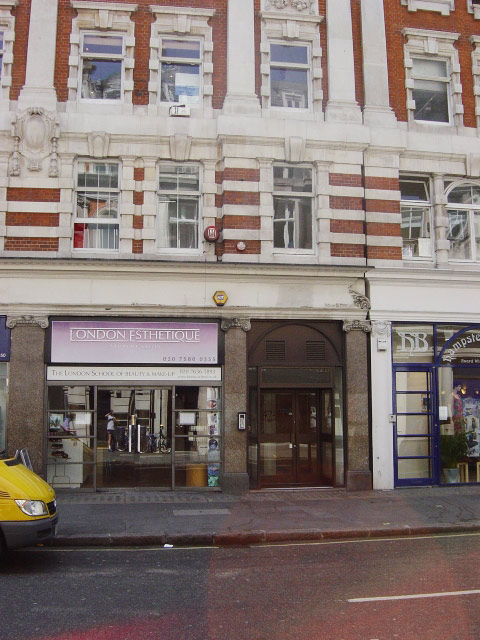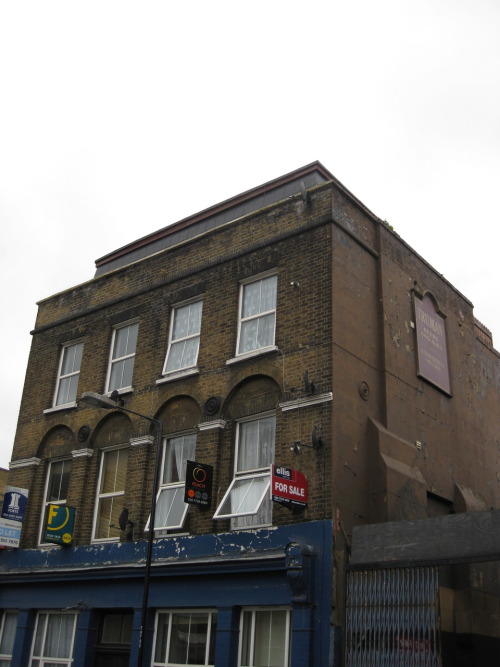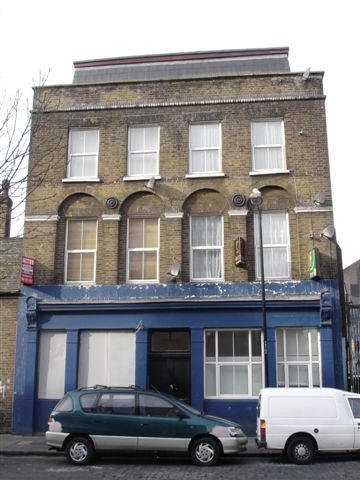The Krays were pair of gangsters who became the most infamous of all the East End and bizarrely sought out the society of celebrities . Eventually, both twins ended up convicted with life sentences for murder and the whole story came to its grim conclusion when Reggie Kray’s funeral cortege passed by the Carpenters’ on its way down Cheshire St on 11th October 2000.  A visit to the East End opens an often unexpected window into British life. Five-hundred years ago the area became home to London's smelly, dirty trades; breweries, slaughter houses and factories were all established downwind of the wealthier West End. The working-class poor who labored at such industry swiftly earned the area a reputation for criminality, and American author Jack London described it as "outcast London."kray school below
A visit to the East End opens an often unexpected window into British life. Five-hundred years ago the area became home to London's smelly, dirty trades; breweries, slaughter houses and factories were all established downwind of the wealthier West End. The working-class poor who labored at such industry swiftly earned the area a reputation for criminality, and American author Jack London described it as "outcast London."kray school below That notoriety was cemented by the Whitechapel "Jack the Ripper" murders in the late 1880s and the Kray twins' gangland empire of the 1960s.
That notoriety was cemented by the Whitechapel "Jack the Ripper" murders in the late 1880s and the Kray twins' gangland empire of the 1960s.
Reggie and Ronnie Kray ruled the East End underworld like feudal lords, and many of the locations made famous by their escapades still remain and can be visited.
Although 178 Vallance Road in Bethnal Green -- where the twins grew up -- has long since been demolished, the road itself is still there, as is their first school, Wood Close in Brick Lane. The twins owned The Speakeasy Club (thespeakeasyclub.com) at 48 Margaret Street
where the twins grew up -- has long since been demolished, the road itself is still there, as is their first school, Wood Close in Brick Lane. The twins owned The Speakeasy Club (thespeakeasyclub.com) at 48 Margaret Street , which hosted performances by The Beatles, David Bowie, Deep Purple, Jimi Hendrix, Bob Marley and The Who. The Speakeasy Club was a late-night haunt for the music industry from 1966 to the late 1970s. The club was managed by Laurie O'Leary (a lifelong friend of the Kray twins) from 1968 to 1977 and Roy Flynn, who was also the first manager of Yes.
, which hosted performances by The Beatles, David Bowie, Deep Purple, Jimi Hendrix, Bob Marley and The Who. The Speakeasy Club was a late-night haunt for the music industry from 1966 to the late 1970s. The club was managed by Laurie O'Leary (a lifelong friend of the Kray twins) from 1968 to 1977 and Roy Flynn, who was also the first manager of Yes.
Known in the business as "The Speak", it included a restaurant and music room. The club took its name and theme from the speakeasies of the American Prohibition era, but in 1967 it changed its theme to an Indian pavilion. Since the club was frequented by record industry and artist agency executives it attracted bands who played for low fees in the hope of being spotted and who would form the basis of the emerging British rock scene as well as international touring bands. The Who refer to the club in their song "Speakeasy" ("Speakeasy, drink easy, pull easy") from the album The Who Sell Out (1967), as does Elvis Costello in his song "London's Brilliant Parade" from the album Brutal Youth (1994). Ronnie Kray was drinking either in The Lion
Ronnie Kray was drinking either in The Lion  The Widows Pub on Tapp
The Widows Pub on Tapp Street when he heard George Cornell, a member of a rival gang, was on his territory.below capenters arms then and now, a kray owned pub.
Street when he heard George Cornell, a member of a rival gang, was on his territory.below capenters arms then and now, a kray owned pub. He was driven home to get a gun, then went to the Blind Beggar pub at 337 Whitechapel Road where he murdered Cornell. Although Bow Street Magistrates at 28 Bow Street
He was driven home to get a gun, then went to the Blind Beggar pub at 337 Whitechapel Road where he murdered Cornell. Although Bow Street Magistrates at 28 Bow Street is now a hotel, the building still looks much as it did when the Krays were charged there. Insider fact: Oscar Wilde was also a reluctant guest. St Mathews Church at Hereford Street
is now a hotel, the building still looks much as it did when the Krays were charged there. Insider fact: Oscar Wilde was also a reluctant guest. St Mathews Church at Hereford Street hosted horse-drawn funeral services for Reggie and Ronnie Kray that famously brought the East End to a halt. Detrain from the Tube at Whitechapel.
hosted horse-drawn funeral services for Reggie and Ronnie Kray that famously brought the East End to a halt. Detrain from the Tube at Whitechapel.
 A visit to the East End opens an often unexpected window into British life. Five-hundred years ago the area became home to London's smelly, dirty trades; breweries, slaughter houses and factories were all established downwind of the wealthier West End. The working-class poor who labored at such industry swiftly earned the area a reputation for criminality, and American author Jack London described it as "outcast London."kray school below
A visit to the East End opens an often unexpected window into British life. Five-hundred years ago the area became home to London's smelly, dirty trades; breweries, slaughter houses and factories were all established downwind of the wealthier West End. The working-class poor who labored at such industry swiftly earned the area a reputation for criminality, and American author Jack London described it as "outcast London."kray school below That notoriety was cemented by the Whitechapel "Jack the Ripper" murders in the late 1880s and the Kray twins' gangland empire of the 1960s.
That notoriety was cemented by the Whitechapel "Jack the Ripper" murders in the late 1880s and the Kray twins' gangland empire of the 1960s.Reggie and Ronnie Kray ruled the East End underworld like feudal lords, and many of the locations made famous by their escapades still remain and can be visited.
Although 178 Vallance Road in Bethnal Green --
 where the twins grew up -- has long since been demolished, the road itself is still there, as is their first school, Wood Close in Brick Lane. The twins owned The Speakeasy Club (thespeakeasyclub.com) at 48 Margaret Street
where the twins grew up -- has long since been demolished, the road itself is still there, as is their first school, Wood Close in Brick Lane. The twins owned The Speakeasy Club (thespeakeasyclub.com) at 48 Margaret Street , which hosted performances by The Beatles, David Bowie, Deep Purple, Jimi Hendrix, Bob Marley and The Who. The Speakeasy Club was a late-night haunt for the music industry from 1966 to the late 1970s. The club was managed by Laurie O'Leary (a lifelong friend of the Kray twins) from 1968 to 1977 and Roy Flynn, who was also the first manager of Yes.
, which hosted performances by The Beatles, David Bowie, Deep Purple, Jimi Hendrix, Bob Marley and The Who. The Speakeasy Club was a late-night haunt for the music industry from 1966 to the late 1970s. The club was managed by Laurie O'Leary (a lifelong friend of the Kray twins) from 1968 to 1977 and Roy Flynn, who was also the first manager of Yes.Known in the business as "The Speak", it included a restaurant and music room. The club took its name and theme from the speakeasies of the American Prohibition era, but in 1967 it changed its theme to an Indian pavilion. Since the club was frequented by record industry and artist agency executives it attracted bands who played for low fees in the hope of being spotted and who would form the basis of the emerging British rock scene as well as international touring bands. The Who refer to the club in their song "Speakeasy" ("Speakeasy, drink easy, pull easy") from the album The Who Sell Out (1967), as does Elvis Costello in his song "London's Brilliant Parade" from the album Brutal Youth (1994).
 Ronnie Kray was drinking either in The Lion
Ronnie Kray was drinking either in The Lion  The Widows Pub on Tapp
The Widows Pub on Tapp Street when he heard George Cornell, a member of a rival gang, was on his territory.below capenters arms then and now, a kray owned pub.
Street when he heard George Cornell, a member of a rival gang, was on his territory.below capenters arms then and now, a kray owned pub. He was driven home to get a gun, then went to the Blind Beggar pub at 337 Whitechapel Road where he murdered Cornell. Although Bow Street Magistrates at 28 Bow Street
He was driven home to get a gun, then went to the Blind Beggar pub at 337 Whitechapel Road where he murdered Cornell. Although Bow Street Magistrates at 28 Bow Street is now a hotel, the building still looks much as it did when the Krays were charged there. Insider fact: Oscar Wilde was also a reluctant guest. St Mathews Church at Hereford Street
is now a hotel, the building still looks much as it did when the Krays were charged there. Insider fact: Oscar Wilde was also a reluctant guest. St Mathews Church at Hereford Street hosted horse-drawn funeral services for Reggie and Ronnie Kray that famously brought the East End to a halt. Detrain from the Tube at Whitechapel.
hosted horse-drawn funeral services for Reggie and Ronnie Kray that famously brought the East End to a halt. Detrain from the Tube at Whitechapel.
No comments:
Post a Comment